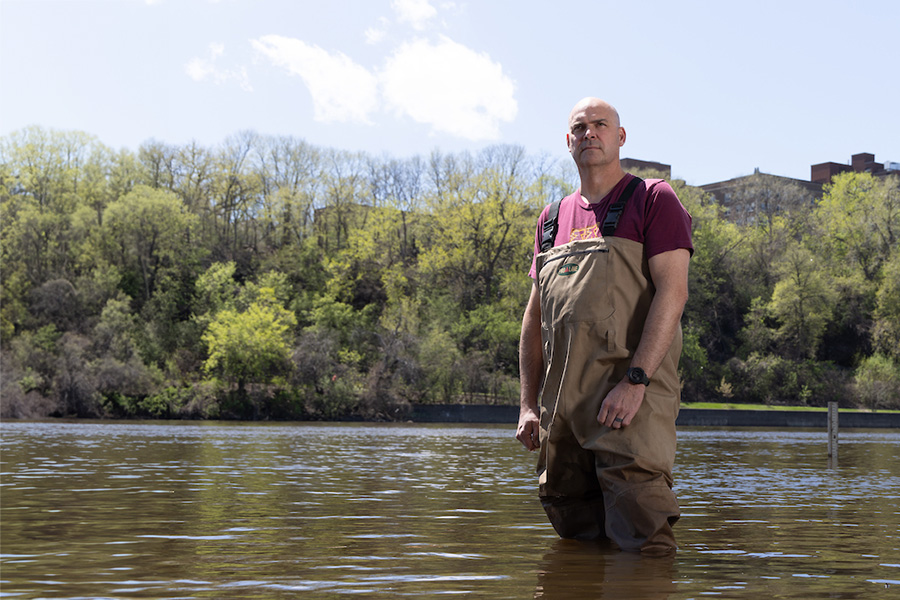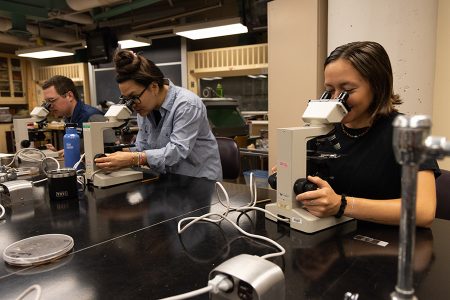
Imagine a substance that can perform an array of valuable services, and is also astoundingly durable. In the 1940s, 3M and DuPont discovered this wonder product. A class of chemicals known as per and polyfluoroalkyl substances — PFAS — offered long-lasting use in a spectrum of applications and products, including stain-resistant fabrics, non-stick cookware, and enhancing the effectiveness of firefighting chemicals.
Eighty years later, PFAS’ ubiquity and durability have come back to haunt humanity. They have been so widely used, are so good at moving around, and are so durable that they’re now found virtually everywhere.
What’s so Bad about PFAS?
And that’s a problem, says Bruce Alexander, professor and head of the School of Public Health (SPH) Division of Environmental Health Sciences. For over 20 years, Alexander has been exploring links between PFAS and human health by studying workers in facilities that produced the chemicals. These workers have experienced levels of PFAS in their blood up to several hundred times that which is seen in the general population. His research has found evidence, albeit limited, of associations with some cancers and cerebrovascular diseases among people who worked in production facilities. Others have reported associations with immune system changes, reproductive challenges, and various health issues in humans and animals.
The jury is still out on the extent to which PFAS pose significant health and environmental threats, but indications are sufficient to warrant concern.
“There certainly are concerns with potential risks [for cancer] or other diseases, but it’s really hard to tell,” Alexander says. “If you have known sources of exposure, you want to do what you can to reduce them.”
SPH Professor Matt Simcik has been working on reducing exposures from sources since the early 2000s — with some encouraging results. An expert in the circulation of chemicals in the environment, Simcik has spent the past two decades learning how PFAS move from one place to another, and how to prevent them from doing so.
“They seem to have some toxic effects, so then the question is, how do we get rid of them?” Simcik says.
Can PFAS Be Contained?
The widespread use of PFAS in firefighting foam and the practice of disposing of waste materials by burying them mean that PFAS, in many instances, have contaminated groundwater. Simcik is working to put an underground fence of sorts around areas of high PFAS concentration to keep that chemical-laden water from migrating toward lakes, streams, and wells that provide drinking water. He has employed existing water treatment chemical compounds to bind PFAS, holding them in place underground while letting water molecules continue to move.
Simcik and colleagues tested the technology last year at a Department of Defense site on the East Coast. Using a stabilized form of activated carbon, they were able to reduce contaminant levels in water to levels so low they were undetectable. In other words, the water was moving across the underground barrier, but the PFAS were not.
Simcik’s team ran a similar experiment at a Department of Defense site in Michigan this past summer. Ultimately, Simcik sees potential applications in preventing PFAS from migrating away from landfills and wastewater treatment plants, where the compounds used in domestic applications tend to concentrate.
“We’re pretty sure they’re not good for us,” Simcik says. “That’s good enough for me to try to get rid of them.”
The one thing that is certain is there is a lot more to learn about PFAS’ health implications and how to reduce risks. To that end, SPH Professor Heather Nelson and colleagues have made PFAS one of the focal points for their National Cancer Institute-funded 10,000 Families Study, which is assessing risk factors for the development of blood cancers throughout Minnesota with special focus on — and engagement of — communities traditionally underrepresented in such research. Over the course of several years, the researchers will be assessing exposure to PFAS, PFAS levels in the blood of participants, and incidence of the cancers potentially caused by PFAS exposure.
“There’s a lot of interest in PFAS because exposure is pretty ubiquitous,” Nelson says. “If there is an association, then we would want to know what is the level of exposure that is associated with risk. That informs how policies happen.”


